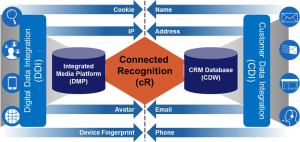Contributeur
Why Your Company Will Need a DMP in the Next 3 Years
Contributeur
For the past five years or so, particularly during the last three, the world of digital marketing has been abuzz with talk about audience data. Buzzwords and conceptualizations abound – terms like first-party and third-party data, as well as acronyms like DSP, DMP, FBX, and SSP, stemming from the early real-time bidding (RTB) revolution and the rise of ad exchanges around 2010.
Yet, in spite of the popularity of these terms, and in spite of the fact that automated and programmatic ad buying platforms are fast becoming the main method of digital ad distribution in the industry, many advertisers and agencies still don’t understand what these fancy acronyms really mean for their organization.
More importantly, many advertisers are falling victim to this fundamental lack of understanding without even realizing that it’s happened. We don’t fully see it now, but this situation will put many businesses at risk while offering tremendous growth opportunities for others.
As the audience data available online and on mobile apps takes on an increasingly strategic role in driving performance, organizations with a better understanding of the way programmatic segmentation can be leveraged will soon leave their less data-savvy competitors behind. The reason for this is as old as marketing itself. The more you know about your customer, the more you can connect with your customer. The more you connect with that customer, the more products and/or services you’ll be able to sell them.
The Data Latency Problem
In the good old days, the main source of data on consumer behaviour came through marketing panels and sample consumer surveys. Using information and insights from these sources, advertisers and agencies would make recommendations on how to improve future promotional campaigns or adapt products or services to better cater to customer needs.
There’s nothing wrong with the above approach, except for the time it takes to receive, process, and act on the data to affect change.
Another way of analyzing customer behaviour is through the analysis of CRM data. This approach tends to be richer in terms of providing descriptive, proscriptive, and ultimately predictive data about customer trends and behaviours.
The problem here again is time. It takes time for analysts to parse through the mountain of information collected in CRM databases, and more time still to turn that information into actionable insights. Moreover, the information often tends to be at a very high level, not to mention that a large Berlin Wall usually exists between the advertiser’s CRM team and the advertising agency. As a result, many organizations use their CRM and data warehousing as mere data hoarding repositories. In the words of Avinash Kaushik, this only produces large sets of data vomit.
Of course, for savvier marketers, particularly those who do much of their business online, the main source of audience data is from web analytics and ad servers. This source of customer data is by far the most granular and indeed, actionable of the three we’ve mentioned so far.
On the one hand, web analytics provide a deep look into the customer journey as it happens throughout the pages of your website or mobile app. Advertisers can see exactly where the customer drops off during the purchase funnel. They can also identify which products are most popular and how they can optimize design and content to positively drive conversions and ROI.
On the other, ad servers enable advertisers and their agencies to see which digital media channels and which media partners (Google, AOL, Yahoo!, Huffington Post, etc.) drive the most results. The ad server also gives a clearer picture of the last touch attributions for your conversions.
As you can imagine, these are important tools. In fact, web analytics and ad serving are probably two of the most indispensable pillars of digital marketing. Without a proper handle on both of these platforms, an advertiser is doomed to fail in 2015.
Still though, there are problems – specifically, in many organizations there is a huge disconnect between web analytics data and ad serving data. In many cases, web analytics are managed internally while the ad server (along with the advertiser data it contains) is owned and operated by the agency.
With the recent integration of Google Analytics Premium with DoubleClick Campaign Manager (DCM), it’s now possible to get a fully integrated view of web analytics and media ad serving. Adviso has performed such integrations for some of our clients and the resulting data opportunities and insights are tremendous to say the least.
-png.png)
Closing the Gap on Audience Data
As you can see, audience data is spread across many different platforms and sources. And unfortunately, in many cases audience data is not even owned (let alone leveraged) by the advertiser – it belongs to the AOR (Agency of Record).
This is a serious problem, a threat even. It means that none of the data collected by an ad server can be transformed into an asset for the company. It also means that the day an advertiser changes its AOR, all the data disappears with the old agency.
This phenomenon isn’t confined to ad serving alone; programmatic ad buys suffer from the same problem, thanks to something called an agency trading desk. In essence, large agency holding companies have found a great way to increase their profit margins and hold their clients hostage at the same time. The recipe is simple and goes something like this:
- Converge all your clients’ programmatic ad spends to boost your purchasing power and finance your own agency trading desk.
- Connect your trading desk to a central, proprietary data management platform (DMP) to hoard all your customers’ first-party audience data.
- Merge all your clients’ data to further boost your data orgy and brag about how much data you have access to.
- Keep your clients hostage by using their own first-party data to secure media performance, while threatening to withhold the data and the increased performance that comes with it if they leave your agency.
- Keep performance data in a black box to reduce transparency on media vs agency margins.
- Use the above as means of retention, double-dipping, and data-hoarding to improve your bottom line.
All the while, the advertiser operates on limited audience data from varied and disconnected sources, unable to connect the dots in order to achieve a truly unified view of the customer.
Furthermore, since most advertisers own neither their ad server license, nor the licenses for the programmatic ad tech platforms used for both millions of their media dollars AND their precious website audience data, they end up seeing stalling and oft-times declining media and business performance overall.
Why Owning Your DMP Could Change Everything
Five or six years ago, data management platforms (DMPs) were almost exclusively licensed by large agencies and online publishers or ad networks. Today, more and more advertisers are realizing the importance of owning their online and mobile audience data. Data is no longer a by-product of advertising; it is an asset for advertising, a very powerful one at that.
Just think of all the opportunities associated with audience data ownership that could be exploited if you had your own DMP.
If you’re still not sure you know enough about DMPs to fully assess the potential gains yet, don’t worry – we’ve put together a few examples to illustrate how useful they can be, as well as a brief description of what a DMP actually is.
What is a DMP?
A Data Management Platform is a technology used to collect, segment, analyze, and deploy very large sets of audience data from three main sources: first-party, second-party, and third-party data. This audience data comes mainly in two forms:
- Browser Cookie ID
- Mobile Device ID
For now, not all DMP solutions are able to collect device ID data. However, the more advanced providers are gradually moving toward cross-device targeting capabilities, allowing you to merge a user’s browser cookie with a device ID, thereby creating a unified user profile. Players like Adobe and AppNexus, the ad tech giant that recently bought MediaGlu, a smaller start-up specialized in probabilistic cross-device mapping, are two examples of players aggressively moving toward a truly multiscreen audience collection, segmentation, and targeting offering.
While audience data will always take one of these two forms when stored and used in a DMP, audiences can be imported from many different sources. Key sources include:
- Your website visitors (first-party)
- Your mobile app users (first-party)
- Visitors to your partners’ websites, or the sites of events or organizations you sponsor (second-party)
- Your CRM customer profiles (first-party)
- Your email list (first-party)
- Data vendors like Lotame, Data Alliance, Google, etc. (third-party)
The beauty of importing data from your CRM files, is that you have the potential to reach customers who may never even have visited your websites or used your mobile apps. They may have arrived in your database through a traditional channel like a DM campaign, for example. Therefore, by importing your CRM data, which may already be well segmented by your CRM team, you open up opportunities to cross-sell, upsell or close sales with profitable segments you otherwise never could have reached via digital advertising.

That’s just one scenario – each data source and data type could be a blog post all onto itself (and we intend to explore these topics soon!). For now, we just wanted to provide a general idea of what could be leveraged within your organization if you owned and controlled your audience data through a DMP.
Audience Extension
Audience extension, also known as Look-Alike modelling, is one of those warmed over buzzwords that came and went without anyone truly understanding what it was all about. That’s unfortunate, because when done right, Look-Alike modelling offers an opportunity to augment your most lucrative audiences and segments by finding and serving ads to people who look just like them.
Using algorithmic segmentation on the big data available in ad exchanges, your DMP can parse and analyze thousands of segments based on hundreds of variables to determine who out there looks like your most loyal customer.
For example, if you sell airplane tickets and you wish to increase the yield on customers opting-in to business class seats, how do you achieve that? Simple. Through your DMP, isolate all those who bought business class tickets into an audience bucket. You can do this by merging data from various sources like your CRM, your website, and your mobile app.
From there, you’ll perform what is called ID mapping on the CRM’s PII segment through a data match provider like Acxiom or Datalogix. These providers are usually already integrated with your DMP. Their job will be to sync the PII of each user from your CRM segment with an existing cookie in the ad exchanges. From there, the PII will be purged (for privacy reasons) and your CRM audience will be transformed into a cookie pool.
Once the pool is ready, you can perform a Look-Alike model in the DMP to find first, second, or third-party segments with the highest Look-Alike index ratio. Some DMPs can be very sophisticated about predicting how much resemblance there is between segments.
When your Look-Alike segment is ready, you can deploy a special campaign promoting your business class options and draw these segments toward conversion. As these users convert, they are also added to your core business class audience pool, giving you a larger portion of this coveted segment. Ultimately, as your most profitable segments grow larger, so should your bottom line and your ROI.
Advanced Audience Analytics
Web analytics platforms are by far the best way to understand your customers’ behaviour when they are on your website, browsing through your pages and products. On the other hand, understanding who your customer is and learning about their behaviour offsite is far more challenging.
With a DMP, your organization can learn and amass mountains of data about who your customers are and what they do when they’re not on your web properties, which likely represents 99.9% of their time.
Audience Analytics Insights is one of the key features provided by data management platforms and it can provide your organization with invaluable knowledge about consumer behaviour. For example, if you found out that your most valuable segment had a tendency to convert when they’re on leisure or LOL websites, how would that affect your brand messaging if your brand traditionally positioned itself as very serious and square?
Potentially, having deeper insights about who your audience is and what matters most to them (based on websites they visit and apps they use) can greatly impact both branding and PR, which ultimately affects conversions.
Testing the Value of Your Partnerships and Sponsorships (Second-Party Data)
Another powerful usage of your DMP is to leverage your various partnerships and sponsorships to create valuable second-party data. Why shouldn’t your company or brand get the most out of those expensive sponsorship deals you paid an arm and a leg for?
By negotiating the right to place a DMP pixel on your partner’s site or that of an event you sponsor, you can turn a branding campaign into a potential cash cow.
In one use case at our agency, we launched a remarketing campaign to the audience of one of our client’s sponsored event websites. Even though the product we were promoting had nothing to do with the event sponsored, the sheer power of brand recognition among that audience generated a conversion rate twice as high as with our other initiatives.
What this showed our client, beyond the benefits of higher conversions, was that their sponsorship was, in fact, influencing a favourable brand perception. When you’re spending millions on a sponsorship, that kind of insight is critical to say the least.
Choosing Your DMP
There are many great DMP solutions available on the market, so which one should your organization choose? In truth, there aren’t any one-size-fits-all answers. Every client is different. Therefore, going through a thorough needs assessment and embarking on a technical RFI process is highly recommended.
If you don’t have anyone in your organization capable of going through the technical process of identifying and evaluating the best solution, it might be best to hire an external consultant specialized in ad tech.
Do consider that a DMP license can be quite an expensive investment, both for the license itself as well as for the IT and marketing resources you’ll need to deploy during implementation. Having a thorough needs assessment done by a professional agency will cost you hours in consulting, but it can cost far more to end up investing in a solution that isn’t right for you.
In the meantime, if you’d like an idea of who the leaders are in the space, you can consult the following study conducted by Forrester in 2013. It is a bit old but still worth the review if you’re new to the DMP space.
In conclusion, there are many advantages tied to licensing a DMP for your organization, even over and above those listed here. If you would like to learn more, don’t hesitate to contact us.

-1.png)











